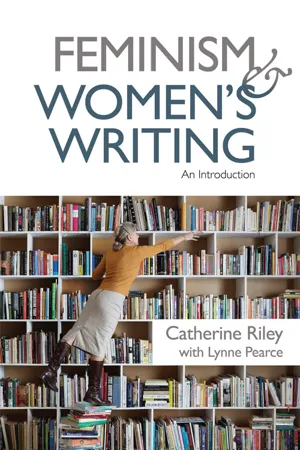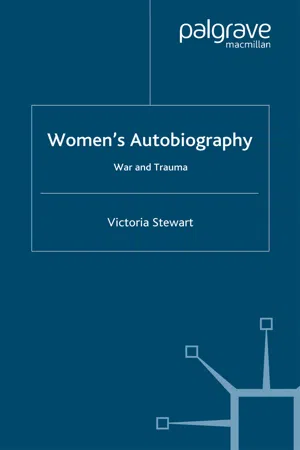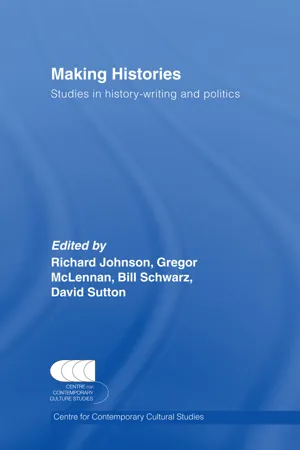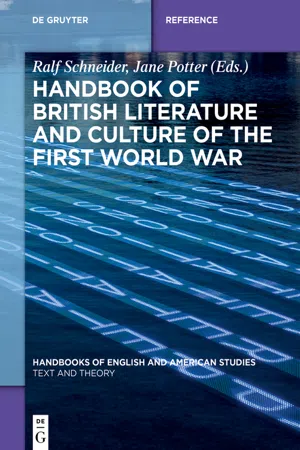Literature
Testament of Youth
"Testament of Youth" is an autobiographical memoir by Vera Brittain, recounting her experiences during World War I. The book provides a poignant portrayal of the impact of the war on the lives of young people, particularly women, and reflects on themes of love, loss, and the struggle for peace. Brittain's powerful narrative offers a compelling insight into the human cost of war and the resilience of the human spirit.
Written by Perlego with AI-assistance
Related key terms
1 of 5
4 Key excerpts on "Testament of Youth"
- eBook - PDF
Feminism and Women's Writing
An Introduction
- Catherine Riley, Lynne Pearce(Authors)
- 2018(Publication Date)
- Edinburgh University Press(Publisher)
One of the most famous of these life stories was that of Vera Brittain, comprising three books, the first of which was published in 1933. Testament of Youth is a remarkable and important autobiography which describes one woman’s experience of the First World War (Case study 9.1). Brittain’s text was one of a number of other ‘feminist’ autobiographies penned in the wake of the first wave which set out the struggles women faced in a culture that was starkly limiting of their freedoms. As her biographer Mark Bostridge explains: for an understanding of Testament of Youth in a broader context, the book needs to be viewed as one of the large number of women’s autobiographies and * It is important to register that autobiography and memoir are two distinct forms: auto- biographies tell a story of the author’s life (often from childhood through to maturity), while memoirs focus on particular episodes and events in a life – often in fragmented and/or non- sequential ways. Not for distribution or resale. For personal use only. 162 FEMINISM AND WOMEN’S WRITING biographical histories published in the twenties and thirties, which attempted to reconstruct and assess the pre-war period and the years between 1914 and 1918. (Bostridge 2004: xiii) These first-wave autobiographies helped institute the idea that the personal was political. Reading women’s autobiographical writing was, in the same way, to form an important aspect of the consciousness-raising that was critical to early formulations of second-wave feminism. Texts such as Sue Kaufman’s Diary of a Mad Housewife (1967) provided literary examples of the frustra- tions women felt in their everyday lives, allowing them a focus through which to express their frustrations. - eBook - PDF
Women's Autobiography
War and Trauma
- V. Stewart(Author)
- 2003(Publication Date)
- Palgrave Macmillan(Publisher)
26 1 Vera Brittain and the ‘Lost Generation’ In Testament of Experience: An Autobiographical Study of the Years 1925–1950 (1957), Vera Brittain describes the effects of writing her first, more famous, autobiographical volume: ‘By enabling me to set down the sorrows of the First War and thus remove their bitterness, Testament of Youth became the final instrument of a return to life from the abyss of emotional death’ (pp. 75–6). This view of auto- biographical writing as facilitating the laying down of a burden is echoed in the 1947 text On Becoming a Writer, which combines practical advice on the submission of manuscripts with reflections on her own writing career: ‘Between 1919 and 1933, I was handicapped, harassed and oppressed by recurrent memories of the first World War, which had brought me such personal tragedy. But after I had published my autobiographical story of that War, those memories never troubled me again’ (p. 32). For Brittain then, writing this book about her experiences, and particularly her losses, appears to have been a means of coming to terms with them, controlling them and, ultimately, putting them to rest for good. Brittain does not empha- size here the other important intention of Testament of Youth (1933), which she states in its Foreword. Here she notes that she wishes to describe what the war meant to ‘the generation of those boys and girls who grew up just before [it] broke out’ (Brittain, Testament of Youth, p. 11), focusing on the middle class to which she herself belonged. This double focus on personal disburdening and on the experiences of a generation remains in tension throughout Testament of Youth, and the various claims which Brittain made for the text have been subject to vigorous critical scrutiny. Whilst it will be - eBook - ePub
Making Histories
Studies in history-writing and politics
- CCCS, Richard Johnson, Gregor McLennan, Bill Schwartz, David Sutton(Authors)
- 2013(Publication Date)
- Routledge(Publisher)
Feminism insists, then, that ‘the ensemble of social relations’ be thought of as still more complex. Moreover, because of the personal character of women’s oppressions in the forms in which they are first experienced, many of the major feminist texts have been quite unlike the main productions of marxist theory. They have taken the form of stories and novels and autobiographical writing, forms of writing that have also managed to capture, however, a sense of representative experience, true for women in a particular historical phase.Vera Brittain’s Testament of Youth seems to us to be a superb example of this kind.84 It centres upon the experience of Vera herself, yet it tells us more than most works of ‘history’ about the experiences of the First World War more generally, and even about the determinations upon events. If such an assessment were agreed, it would be worth considering what it is that makes this book so successful.Our own answers relate back to the more general arguments about individuals and social relations. Part of the strength of Testament of Youth lies in its author’s location within key sets of social relations, especially, in this case, relations of gender. This is ‘lived’ in her own personal relationships, especially with her brother, her lover and their mutual male friends in the years before the War. The War impacts on these relationships in a way that is not merely representative of the position of women at this time, but has a kind of super-representative character. Vera’s own life is massively, crushingly over-determined by the European holocaust; she loses a much-loved brother, the man whom she hopes to marry, and her other male friends. Her own active response to the threat and reality of this is to become involved in the War herself, as directly as she possibly can. So she becomes a nurse in the battlefields of Europe, and further experiences the contrast between the idealistic hopes of young men going to the War and the physical and mental effects of their mutilation. This in turn removes her both from the certainties of her own middle-class family and from the naivety of most of her later fellow-students at Oxford. In a very important sense, Vera personifies the woman’s experience of the First World War, something that she herself began to realize as she wrote Testament of Youth - Ralf Schneider, Jane Potter, Ralf Schneider, Jane Potter(Authors)
- 2021(Publication Date)
- De Gruyter(Publisher)
13 Vera Brittain, Testament of Youth (1933) 243 intense sharpening of all the senses, the vitalising consciousness of common peril for a common end, remain to allure those boys and girls who have just reached the age when love and friend-ship and adventure call more persistently than at any later time. ( TY 291 – 292) Even as she identifies this “ allure ” , however, the tension at the heart of Testament of Youth , which undermines her pacifist agenda, is one that she is seemingly uncon-scious of, but which is inextricable from the narrative of grief and mourning: in com-memorating her dead, she cannot find an alternative to the heroic rhetoric that was in-strumental in sending them to war. Brittain ’ s dilemma in remembering and mourning is a problem of the relationship between language and emotion. If “ the War was a tra-gedy and a vast stupidity, a waste of youth and of time ” ( TY 290), how then how can she pay tribute to her dead. The competing languages that reject war on the one hand, but construct heroic death on the other, thus point to the complexity of grief and the need for language that would console Brittain for their loss. Grief psychologist Nei-meyer affirms that “ individuals make meaning by drawing selectively on a fund of dis-course that precedes them and is consensually validated within their cultures ” . (Nei-meyer 2001, 264) Winter argues that “ [t]raditional modes of seeing the war [ … ] provided a way of remembering which enabled the bereaved to live with their losses ” (Winter 1995, 115). These “ traditional modes ” draw on the “ fund of discourse ” through which the larger culture offers consolation and meaning for wartime deaths. More-over, Kazantsis reminds us that the predicament for non-combatant women was espe-cially difficult, since to question the values for which soldiers ostensibly died is “ to question the Sacrifice itself – impossible. For then his death must become not only horrible but also meaningless.
Index pages curate the most relevant extracts from our library of academic textbooks. They’ve been created using an in-house natural language model (NLM), each adding context and meaning to key research topics.



